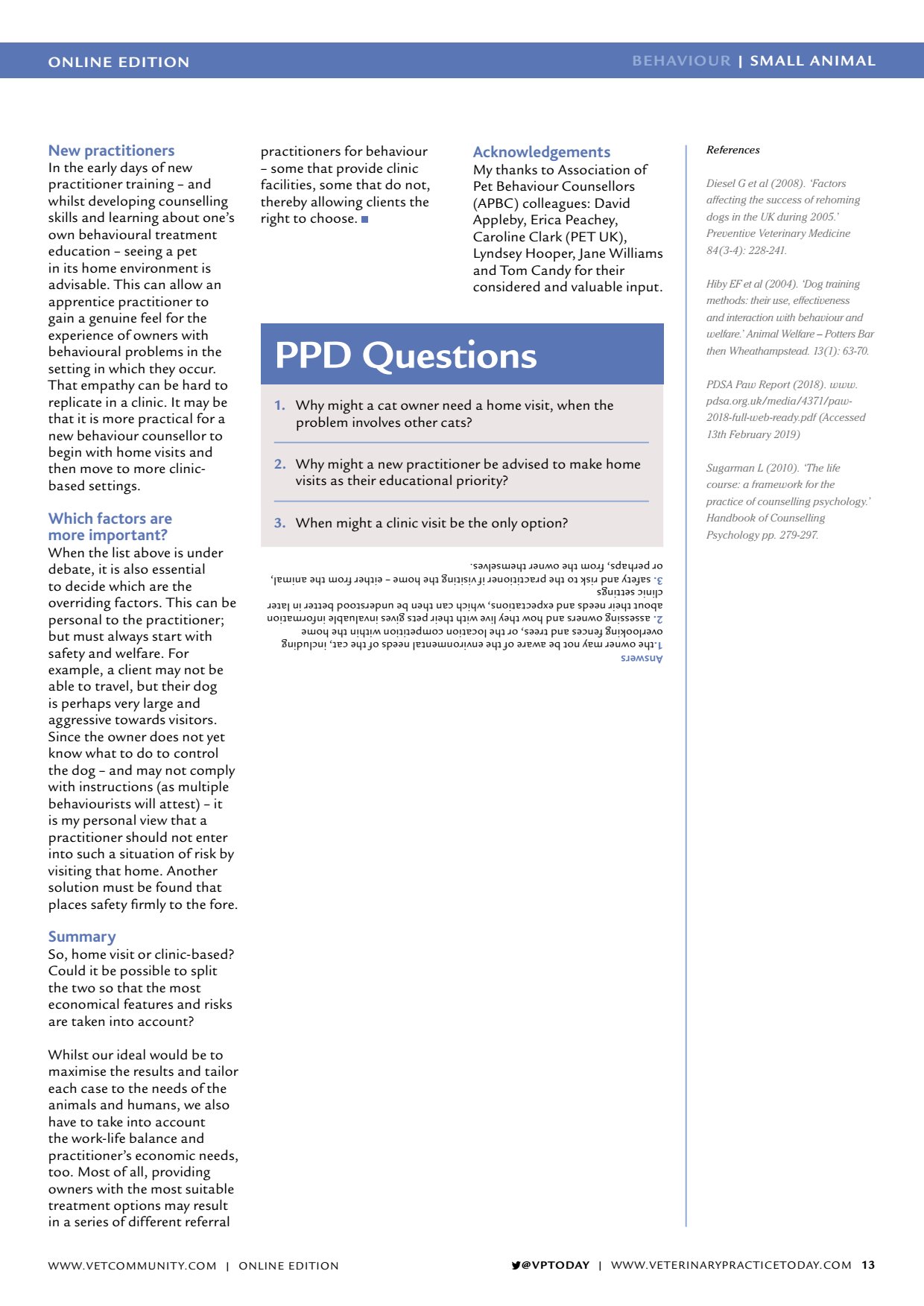Questions practitioners Which
ONLINE EDITION BEHAVIOUR | SMALL ANIMAL VPTODAY | WWW.VETERINARYPRACTICETODAY.COM 13 References Diesel G et al (2008). Factors affecting the success of rehoming dogs in the UK during 2005. Preventive Veterinary Medicine 84(3-4): 228-241. Hiby EF et al (2004). Dog training methods: their use, effectiveness and interaction with behaviour and welfare. Animal Welfare Potters Bar then Wheathampstead. 13(1): 63-70. PDSA Paw Report (2018). www. pdsa.org.uk/media/4371/paw- 2018-full-web-ready.pdf (Accessed 13th February 2019) Sugarman L (2010). The life course: a framework for the practice of counselling psychology. Handbook of Counselling Psychology pp. 279-297. PPD Questions 1. Why might a cat owner need a home visit, when the problem involves other cats? 2. Why might a new practitioner be advised to make home visits as their educational priority? 3. When might a clinic visit be the only option? Answers 1. the owner may not be aware of the environmental needs of the cat, including overlooking fences and trees, or the location competition within the home 2. assessing owners and how they live with their pets gives invaluable information about their needs and expectations, which can then be understood better in later clinic settings 3. safety and risk to the practitioner if visiting the home either from the animal, or perhaps, from the owner themselves. New practitioners In the early days of new practitioner training and whilst developing counselling skills and learning about ones own behavioural treatment education seeing a pet in its home environment is advisable. This can allow an apprentice practitioner to gain a genuine feel for the experience of owners with behavioural problems in the setting in which they occur. That empathy can be hard to replicate in a clinic. It may be that it is more practical for a new behaviour counsellor to begin with home visits and then move to more clinic- based settings. Which factors are more important? When the list above is under debate, it is also essential to decide which are the overriding factors. This can be personal to the practitioner; but must always start with safety and welfare. For example, a client may not be able to travel, but their dog is perhaps very large and aggressive towards visitors. Since the owner does not yet know what to do to control the dog and may not comply with instructions (as multiple behaviourists will attest) it is my personal view that a practitioner should not enter into such a situation of risk by visiting that home. Another solution must be found that places safety firmly to the fore. Summary So, home visit or clinic-based? Could it be possible to split the two so that the most economical features and risks are taken into account? Whilst our ideal would be to maximise the results and tailor each case to the needs of the animals and humans, we also have to take into account the work-life balance and practitioners economic needs, too. Most of all, providing owners with the most suitable treatment options may result in a series of different referral practitioners for behaviour some that provide clinic facilities, some that do not, thereby allowing clients the right to choose. Acknowledgements My thanks to Association of Pet Behaviour Counsellors (APBC) colleagues: David Appleby, Erica Peachey, Caroline Clark (PET UK), Lyndsey Hooper, Jane Williams and Tom Candy for their considered and valuable input. WWW.VETCOMMUNIT Y.COM | ONLINE EDITION
